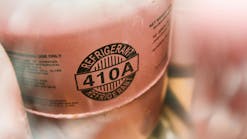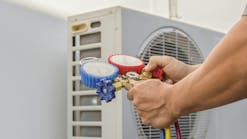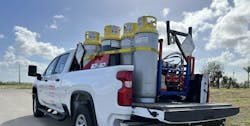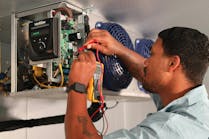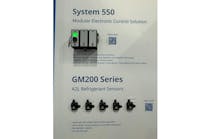Refrigeration 101: Traditional & Secondary Supermarket Refrigeration Systems
Direct expansion (DX) and secondary loop (SN) systems are two approaches to medium temperature supermarket refrigeration that have become established in the marketplace. direct expansion has been around a long time, and secondary loop systems have been in use for more than a decade.
A major difference between the two types of systems is in the amount of refrigerant they use. SN systems generally require half as much refrigerant as comparable DX systems. Due to environmental concerns and regulatory pressures, the number of SN systems being installed is continuing to increase.
Basic Differences
In comparing the two approaches, some basic differences stand out. DX relies on the refrigerant undergoing a change of state from a liquid to a vapor as it moves through the evaporator. The liquid refrigerant entering the evaporator boils as it absorbs heat from the air in the case flowing over the coil.
In SN refrigeration there’s no change in state of the secondary coolant that circulates through the cases. The glycol fluid that serves as the coolant in the system absorbs heat through the secondary heat exchangers, which raises its temperature but does not cause it to boil.
The differences between the two approaches can be best understood by closely looking at how the two types of systems operate.
DX System Operation
A traditional supermarket DX system (Fig.1) is made up of four main basic components; compressors, condensers, expansion valves, and evaporators. As already noted, the DX refrigeration process relies on the refrigerant in the system changing back and forth between a liquid and a gas. The process is cyclical, but for purposes of discussion, the change in state can be said to initially occur at the evaporators in the display cases and other fixtures connected to the system. Heat absorbed by the refrigerant results in a pressure change that causes the compressors to begin pulling refrigerant vapor from the suction lines. The refrigerant at this point is in a vapor state because of the temperature difference it encounters as relatively warm air flows across the evaporator coils. This start of the process is referred to as the system calling for refrigeration.
The refrigerant flows from the compressors into the condenser as a high-pressure superheated vapor. Relatively cooler air passing through the condenser removes heat from the refrigerant, changing the state of the refrigerant into a saturated mixture of liquid and vapor.
From the condenser, the refrigerant in most traditional systems moves into a receiver which works as a reservoir. Liquid refrigerant flows from the receiver into an expansion valve that meters the flow of refrigerant from the high-pressure, high-temperature side of the system to the low-pressure, lower-temperature side.
After leaving the expansion valve, the refrigerant returns to the evaporator where the process began. Here, the liquid refrigerant absorbs heat causing it to boil, or change state, back into a vapor. Once the refrigerant is entirely vapor, additional heat from the evaporator superheats the refrigerant.
The superheated vapor returns to the compressors as the process starts over when the system calls for refrigeration.
Taking R-404A refrigerant as a hypothetical example, the approximate pressures, temperatures and state of the refrigerant at various points in a basic system are shown in this chart:
Secondary System Operation
The secondary system is made up of two sub-systems; the primary DX side and the secondary SN side. (Figure 2 depicts the layout of the two systems working in unison.) The secondary system adds to the DX process by incorporating a hydronic, or fluid-circulating, process that moves the evaporation point from the display cases and other fixtures to a close-coupled chiller mounted on, or near, the DX system. The secondary coolant absorbs heat but doesn’t change state as it circulates through finned-tube, fully-flooded heat exchangers located at the cases and other fixtures. Heat absorbed by the coolant is then transferred to the primary side of the system through the chiller, which serves as the evaporator for the DX side.
Heat exchangers in the system are connected through a closed-loop fluid piping system instead of a circuited piping system often found in DX systems. Although a pressure difference created by the pumps is responsible for circulating the coolant, secondary systems typically operate at no higher than the 60 psi of pressure supplied by the pump. Thus, either water-grade Type-M copper, or engineered plastic piping can be used.
Case temperature is determined by the flow rate and temperature of the fluid circulating through the heat exchanger. No TXVs are in the case. The primary side determines side the temperature of the fluid. The overall flow rate for the system is determined by the size and number of pumps that are running. The pumps can also be more efficiently controlled by the use of variable speed drives.
Comparison of the Systems
Since both types of systems, to some extent, use DX refrigeration, most of the notable differences between them have to do with the portions of the systems located out in the store. These differences include:
• Loop (SN) vs. circuited piping (DX)
• Water-grade engineered plastic and M-copper (SN) vs. L-copper piping material (DX), which reduces installation costs
• Lower piping pressures: 20- to 60-psi (SN) vs. 55- to 280-psi (DX)
• Fully-flooded heat exchangers (SN) vs. traditional evaporators that increase efficiency and improve product integrity (DX)
• Balance valves (SN) vs. thermal expansion valves (DX), reducing maintenance requirements and troubleshooting procedures.
In the machine room, besides the pumps and associated equipment, the differences include:
• The only TXVs in the entire system are for the chiller (SN) vs. 50 or more in a DX system
• Significantly less charge (from 600 to 900 pounds per rack for SN systems vs. 1500 to 2000 pounds per rack for DX systems).
Overall differences between the two types of systems include:
• Reduced installation costs for SN systems, due to reduced
copper and refrigerant, among other factors
• No TXVs or brazed joints (in the store) are used in SN
systems, which provides more precise capacity control and eliminates a major source of potential leaks
• Neither nitrogen nor any line evacuation is required during installation of an SN system
• Refrigerant plus glycol coolant in SN costs less than refrigerant alone for typical DX
• SN systems require lower maintenance, which in a conservative estimate saves thousands of dollars annually.
Although direct expansion has been the mainstay of the industry, many contractors are becoming more comfortable working with secondary. For this reason, and others mentioned in this article, this trend is expected to continue.

